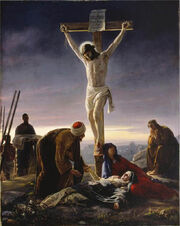| After the torch-light red on sweaty faces | |
| After the frosty silence in the gardens | |
| After the agony in stony places | |
| The shouting and the crying | 325 |
| Prison and place and reverberation | |
| Of thunder of spring over distant mountains | |
| He who was living is now dead | |
| We who were living are now dying | |
| With a little patience | 330 |
Allusions[]
This final section opens with images after Jesus was taken prisoner in the garden of Gethsemane and after the cruxification itself. The “torchlight red on sweaty faces” perhaps indicates the guards who come to take Christ away; the “garden” is Gethsemane; “the agony in stony places” refers to the torture and the execution itself; and “of thunder of spring over distant mountains” describes the earthquake following the crucifixion.

Jesus being crucified in the Garden of Gethsemane
Analysis[]
Life and death are linked, their borders blurred at times: “He who was living is now dead / We who were living are now dying / With a little patience.” Eliot emphasizes the chaos and disorganization of society through the use of juxtaposing images such as "shouting" and "crying" and "prison" and "palace." "We who were living are now dying" here portrays the processes of birth, death and rebirth. In this stanza, Eliot is trying to say that society is slowly dying an eternal death.